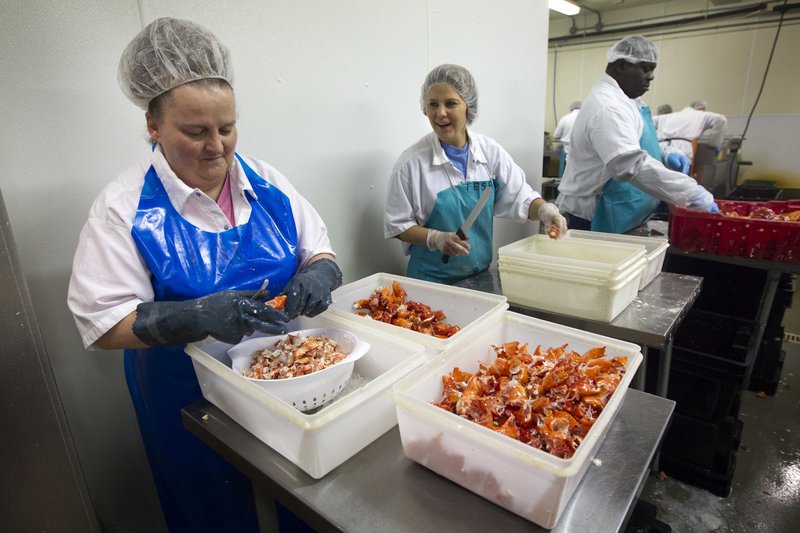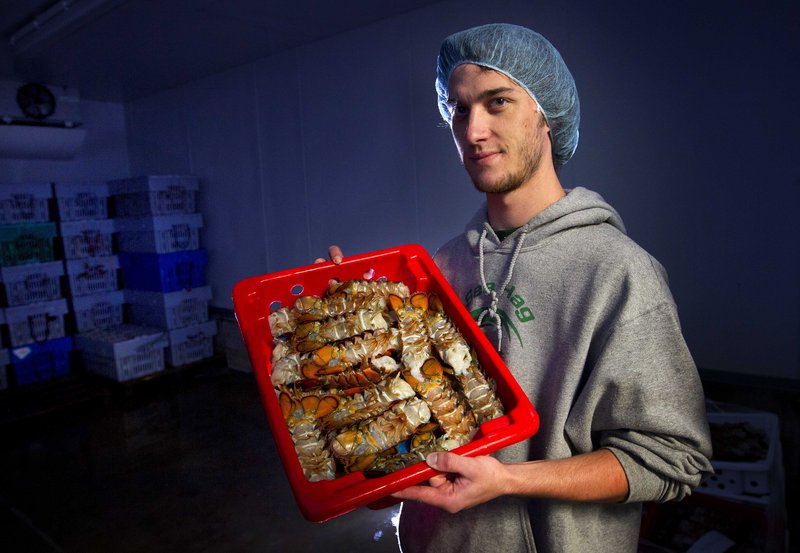ST. GEORGE, Maine – For years, Maine’s lobster processing industry was on simmer. But with the help of a glut of the state’s signature seafood and a few savvy entrepreneurs who spotted a hole in the market, it’s on its way to a rolling boil.
Take 24-year-old Kyle Murdock, who decided to stop his studies in physics and math at Worcester Polytechnic Institute in Massachusetts to open Sea Hag Seafood, named after his father’s lobster boat.
Fishermen began talking about the need for more in-state processors, which turn whole live lobsters into frozen tails, picked meat and other products, after the global economy tanked in 2008, driving down demand and prices, Murdock said.
“But that’s always where the conversation ended,” he said. “Nobody ever continued the conversation with, ‘Why don’t we have more processing capacity, or how do we get more processing capacity?’ “
His plant processed 600,000 pounds last year after opening in August in the seaside town of St. George, and he’s planning to handle 2.5 million pounds this year.
When Maine’s lobster catch averaged about 20 million pounds a year from the 1950s through the 1980s, there was no need to have processors in Maine. Much of the catch was sold live, with the rest shipped to Canada, which has more than two dozen processors. Maine didn’t have any processors to speak of before the 1990s, and has had only three or four of any size in recent years.
But the catch has risen fast over the past 20 years – from 30 million pounds to last year’s record 126 million pounds — and only a small portion is sold live. The rest, some 80 percent or more, is processed and sold to restaurants, retailers, theme parks, cruise ship lines and other buyers around the world.
The call to increase Maine’s processing capacity grew louder and drew national attention last summer after a huge early haul of lobsters caused a market glut and a crash in wholesale prices. Fearing for their livelihood, Canadian fishermen angrily blocked truckloads of Maine lobsters from being delivered to processing plants in Canada.
Less than 10 percent of Maine’s lobster catch is now processed in Maine, with an estimated 60 to 70 percent shipped to Canada for processing, Murdock said.
Maine’s plants currently handle an estimated 10 million to 12 million pounds annually. Murdock doesn’t see any reason why Maine can’t be processing more than half the harvest that isn’t sold live. Adding processing capacity gives the Maine industry more control over its product while boosting employment and the value of the catch, he said.
“If we could process 40 million pounds, I think that’s where we need to be,” he said on a recent day at his plant.
Although Murdock comes from a fishing family and ate lobster four to five times a week while growing up on Monhegan Island, he didn’t know much about processing until he set to get into the business. So he hired a consultant to help with the startup and spent a couple of weeks at a Canadian plant to learn the ropes.
He now has nearly 50 employees at work and said the workforce will grow to 60 or 70 later in the summer.
There’s nothing pretty about processing lobsters. At Sea Hag, workers dressed in vinyl aprons, rubber boots and hairnets snap the tails off live lobsters and cut off their claws and legs as country music blares on the radio. The tails are sorted by size on a conveyor belt and frozen in a tank of circulating minus-2 degree seawater before being packed and shipped as a product of Maine.
The legs and claws are boiled in a 350-gallon cooker, and workers pick the meat out of the legs and crack open the claws so they can shake out the meat in one piece. The meat is packed in 2-pound bags and frozen in a freezer at minus 40 degrees.
Similar scenes are playing out across Maine in new places.
A Portland lobster wholesaler, Ready Seafood, opened a plant in Scarborough in September and plans to process about a million pounds this year. Richmond-based Shuck’s Lobster plans to open another plant in Portland next year that will double its processing capacity.
Luke’s Lobster, a chain of 11 lobster roll eateries in New York, Washington and Philadelphia, started a new business to open its own processing plant in Saco this spring, solely to process products for its stores. President Luke Holden said the plant gives the company more control over supply.
“We’re interested in controlling our own destiny and making sure what we get is a high-quality product,” Holden said.
The largest of the state’s new processing plants opened in June in a 100,000-square-foot plant in Prospect Harbor in eastern Maine that used to house the nation’s last sardine cannery, which closed three years ago. Maine Fair Trade Lobster won’t divulge its production goals, but it already has nearly 100 employees and plans to have 300 within three years, said spokeswoman Christina Ferranti-Clift.
Besides creating jobs, the increased lobster processing will help Maine brand its lobster products, said Marine Resources Commissioner Patrick Keliher. The Maine catch that’s now processed in Canada is sold as a Canadian product even though it was caught in Maine.
There are obstacles to growth – most notably a shortage of workers and high energy costs — but Keliher expects processing capacity to grow fast in the years ahead.
“While live markets exist all over the world, a big part of the future of Maine lobster lies in processed, easy-to-use products,” he said.
Murdock concurred, noting that the future of the industry depends on processing because most people don’t want to cook a live lobster in their kitchen.
“The American consumer,” he said, “wants a convenient product.”
Send questions/comments to the editors.



